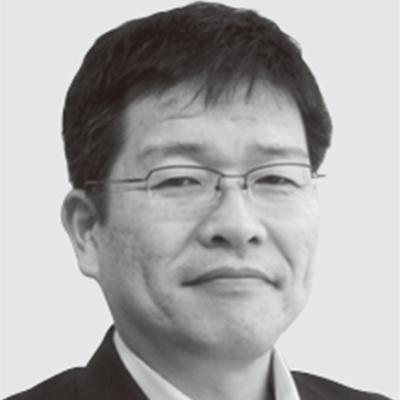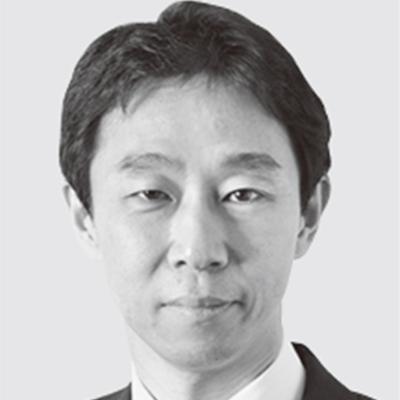Disaster Management and Security Solutions for a Safe and Secure Way of Life
Hitachi is developing area security solutions that help overcome management challenges. This initiative is helping to improve operational efficiency as well as strengthen security by combining information from surveillance cameras and other sensors, and by subjecting this collated data to advanced analyses. Meanwhile, an advanced firefighting command system intended as a solution for improving the safety and security of communities not only provides additional control desk functions, it also helps achieve a prompt response to fires by providing disaster management information and the sharing of information with people on site.

Security Business Planning Department, Security Business Strategy Division, Security Business Division, Service Platform Business Division Group, Services & Platforms Business Unit, Hitachi, Ltd. Current work and research: Business reclamation of security solutions for social infrastructure.

Smart Mobility Development Department, Smart Society Division, Urban Solutions Business Unit, Hitachi, Ltd. Current work and research: Planning and development of urban solution systems.

Global Business Development Department, Urban Solutions Business Unit, Hitachi, Ltd. Current work and research: Business and solution development for urban development projects overseas.

Industrial Manufacturing Solutions Division, Security Engineering Department, Industrial Solutions Division, Industry & Distribution Business Unit, Hitachi, Ltd. Current work and research: Security solutions business.

Disaster Management & Safety Systems Department, Social Infrastructure Solution Operation, Government & Public Corporation Information Systems Division, Government, Public Corporation & Social Infrastructure Business Unit, Hitachi, Ltd. Current work and research: Development of information systems for fire agencies.
Many risks lurk in the urban neighborhoods where people go about their business. These include the sort of terrorist acts that are a frequent occurrence overseas, unexpected criminal activity resulting in injury, natural disasters such as sudden rainstorms or earthquakes that strike without warning, traffic accidents, and fires. As Japan is set to host major international events in 2019 and 2020, dealing with these increasingly diverse and complex risks is an urgent issue.
Hitachi supplies area security solutions for dealing with these risks that, in addition to improving security and convenience, also help overcome business challenges such as how to adopt best practices. In other words, by combining information from different sources such as surveillance cameras and intruder detection sensors, and using technologies such as image analysis and artificial intelligence (AI) to perform sophisticated data analysis, the solution can help overcome business challenges as well as strengthen security.
Hitachi believes its area security solutions are suitable for use over large areas, including airports and the neighborhoods around railway stations that may contain a variety of different facilities, such as transportation services, shopping complexes, and housing, and also at major sites administered by a particular infrastructure operator, such as power stations or large industrial plants.
Other solutions supplied by Hitachi that contribute to community safety and security in ways that go beyond area security include firefighting command systems that deal with calls reporting fires or other emergencies and issue instructions to fire stations and appliances.
This article describes examples of area security solutions and profiles advanced firefighting command systems, both supplied by Hitachi.
Hitachi security solutions aim to protect entire neighborhoods around railway stations from the threat of terrorist attack while also helping improve services for the increasingly diverse range of users.
Railway station neighborhoods face a variety of threats that include terrorist attack, accidents, intruders, and natural disasters. Meanwhile, practical assistance needs to be provided to numerous users of railway station neighborhoods, such as overseas visitors, the elderly, lost children, wheelchair users, and the visually impaired.
It is frequently the workers responsible for operating the railway station, managing security or cleaning, providing information, and looking after the facilities who identify these threats or people requiring assistance and take the initial steps to handle them, with follow-up action being taken if needed such as notifying local government, police, fire department, or other services. Unfortunately, with threats increasing, a greater diversity of people requiring assistance, and the aging of the workforce, there is potential for the response to be delayed or for this to impede their primary work.
Hitachi's security solutions not only strengthen security in ways that include using the latest access control and surveillance camera systems to prevent intruders, but can also identify threats or people requiring assistance automatically using surveillance camera video and data from Internet of Things (IoT) sensors. The solutions provide a fast and efficient response to threats or people requiring assistance by configuring and operating an integrated surveillance system that includes area security, disaster prevention, and facility management together with a platform for sharing information with the various stakeholders who administer the area (see Figure 1).
In this way, Hitachi security solutions will continue to respond to evolving threats and serve people requiring assistance by utilizing and integrating the latest technologies, while also helping create urban developments that are safe, secure, and comfortable as well as more efficient to administer.
Figure 1—Area Security for Railway Station Neighborhoods In addition to strengthening security in ways that include using the analysis of surveillance camera video and data from IoT sensors for the automatic detection of suspicious individuals, this also enables more timely provision of assistance to the elderly or others who need it.
In addition to strengthening security in ways that include using the analysis of surveillance camera video and data from IoT sensors for the automatic detection of suspicious individuals, this also enables more timely provision of assistance to the elderly or others who need it.
Recent years have seen terrorist incidents involving explosives or firearms in Europe, America, and Southeast Asia, particularly at airports. Meanwhile, major airports in Japan have been subject to a series of cyberattacks over the last few years. With these airport security risks rising throughout the world, and with Japan set to host major international events, there is an urgent need to strengthen its countermeasures for dealing with terrorist attacks in both the physical and cyber spheres.
Airports have traditionally taken steps to strengthen security, using metal detectors, X-ray machines, explosives detection systems, access control systems for airport staff, and surveillance systems that include security cameras and intruder detection sensors. In recent years, these have also been augmented by using technologies such as biometrics and image analysis to further strengthen security.
Hitachi is using fast and highly secure finger vein authentication to improve the security and convenience of site access control for airport staff. It is also working on the use of real-time analysis of surveillance camera video both to enhance security by detecting suspicious items that have been abandoned and to make airport operations more efficient by determining the level of foot traffic through different locations, for example(1). Hitachi is also helping improve security from cyberattacks, both through upstream consulting on security assessments and by supplying solutions that provide multiple levels of protection ranging from outward- to inward-facing defenses, such as the detection of unauthorized communications.
As an important part of the social infrastructure, power plants face a variety of threats that include the recent increase in the risk posed by terrorist attack and from suspicious people or items, and also difficult-to-prevent natural disasters like earthquakes or tsunamis. When raw materials for use in power generation are imported from overseas, it is also necessary to review and further strengthen physical security to comply with requirements such as those stipulated in international treaties like the International Convention for the Safety of Life at Sea (SOLAS).
Meanwhile, recent problems with labor shortages and working hours also apply to power plants, while the diminishing numbers of young people due to the falling birthrate mean that there is even greater interest than ever in the productivity of individual workers. With an increasing number of power companies speaking of a new era in “work style reform,” this is giving rise to a need for improvements in the productivity of on-site and other inspection work, and for automatic monitoring of equipment condition to ensure a reliable supply of electric power throughout the power plant.
Through the application and installation of security solutions that include access control systems and surveillance cameras, Hitachi is able to contribute to keeping staff safe from suspicious people or items, and also to improvements in worker productivity achieved by using surveillance video data.
To ensure staff safety and security, use of the latest technology for access control systems and analysis of surveillance camera video makes it possible to use tags or biometric authentication to prevent intruders, and to use video footage to detect abandoned or otherwise suspicious items. This can reduce the excess workload that measures for dealing with things like suspicious people or items place on security and other on-site staff.
Use of the above systems in tandem with technologies that use sensors and multi-function cameras, such as those with nighttime detection capabilities, can also provide better compliance with SOLAS.
The productivity of on-site and other inspection work can be improved by using the analysis of surveillance camera video to automate some of the equipment checks conducted by staff carrying out on-site inspections at power plants. By utilizing beacons to enable the route taken by staff carrying out on-site inspections to be analyzed, it is also possible to reduce the time required for planning the optimal route. Solutions that use drones can also be provided for covering large areas or inspecting equipment in elevated locations. Implementing these systems as plug-ins to an integrated physical security platform(2) enables the centralized management and use of information, making it easy for the same screen to provide data from both operational technology (including operation monitoring and perimeter monitoring) and information technology (including image analysis and location detection). This allows each system administrator to choose the information they want and to manage it efficiently (see Figure 2).
In this way, Hitachi security solutions will contribute to the reliable supply of electric power both by underpinning safety and security at power plants and through ongoing support for incremental improvements in worker practices.
Figure 2—Overview of Disaster Security at Power Plants Combining information from a variety of sensors, including surveillance video data, beacon data, and drone data, on an integrated physical security platform contributes to stronger security and to improvements in productivity and equipment utilization.
Combining information from a variety of sensors, including surveillance video data, beacon data, and drone data, on an integrated physical security platform contributes to stronger security and to improvements in productivity and equipment utilization.
Along with growing concern about disaster prevention, the role of the fire departments charged with responding to disasters is becoming more complex. Given societal factors that include demand for ambulance dispatch growing annually as the population ages and regional fire departments that include emergency fire response teams, the need for information sharing and efficiency improvement in firefighting command systems is rising rapidly. Likewise, there is a need to keep pace with the technical developments in firefighting, which include the shifting of 119 emergency calls to Internet Protocol (IP) communications and the use of smart devices at the sites of incidents.
Hitachi has experience from developing a number of firefighting command systems, including for the Tokyo Fire Department, and is engaged in work on realizing the next generation of firefighting command centers that draws on various different types of activity. The following sections describe Hitachi's advanced firefighting command systems from recent years, an example installation, and work on realizing a new generation of command centers.
Figure 3—Example Installation of Hitachi Advanced Firefighting Command System at the Kyoto City Fire Department Along with additional control desk functions, the system facilitates a more rapid response by making firefighting information available quickly and sharing information with teams in the field.
Along with additional control desk functions, the system facilitates a more rapid response by making firefighting information available quickly and sharing information with teams in the field.
The most important information for firefighting in an emergency is the advanced firefighting command system that manages the sequence of steps from receiving the emergency call, assembling the response team, issuing instructions to fire stations and appliances, through to the final resolution of the incident. The latest advanced firefighting command systems are equipped with the following key functions for sharing information and making command and control more efficient.
The use of tablets by response teams can provide medical information (such as the ability of hospital emergency departments to accept more patients) in real time and help speed up decisions about which hospital to take people to.
How to acquire different forms of information quickly to make situation assessments, and whether the response can be mounted quickly and safely, are crucial issues at time-critical incident sites. With the spread of smart devices, social networking services, and various sensors and other IoT devices, there is scope for command centers to take on new forms that are adapted to changes in society, including new ways of making emergency calls that in the past could only be made by telephone, and methods of active fire detection using information from sensors.
Hitachi has proposed the concept of a next-generation command center for meeting these upcoming requirements (see Figure 4). The aim is to help with prediction, simulation, and the optimization of on-site activities. Examples include implementing a call handling function that can receive emergency calls in both video and voice from the smartphones that have entered widespread use in recent years, and an automatic search function that uses Hitachi's Lumada IoT platform for the collection and analysis of information, such as data on past incidents or patients, and performs triage* for people in need of attention or determines where to take them for emergency treatment based on predictive diagnosis of their medical condition. In terms of disaster management, firefighting and disaster management (civil defense) are handled by separate organizations at many local governments in Japan, with frequent instances in which the sharing of both equipment and information is ineffective. By merging and integrating this regional disaster management information with information on disaster management and important facilities provided by central government, Hitachi believes that a next-generation command center will enable the sharing of equipment and information for firefighting and disaster management in ways that have not been possible in the past, and thereby establish flexible fire and civil defense arrangements that are better equipped to cope with disasters.
Figure 4—Services for Implementing Next-generation Command Hitachi sees applications for its IoT platform, Lumada in the firefighting sector also.
Hitachi sees applications for its IoT platform, Lumada in the firefighting sector also.
This article has described examples of Hitachi's area security solutions for helping keep communities safe and secure, and profiled advanced firefighting command systems.
In the future, Hitachi will continue to focus development on advanced technologies such as AI and image analysis, and will apply the outcomes to making more advanced solutions. Hitachi will also continue to contribute to the safety and security of communities through ongoing development and supply of solutions with enhanced functionality that are easy to use.
The authors would like to take this opportunity to once more express their deep appreciation for the considerable assistance provided by the people involved at the Kyoto City Fire Department during the work on their advanced firefighting command system used as an example in this article.